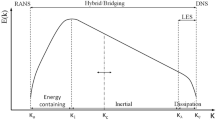Abstract
Model-form uncertainties in complex mechanics systems are a major obstacle for predictive simulations. Reducing these uncertainties is critical for stake-holders to make risk-informed decisions based on numerical simulations. For example, Reynolds-Averaged Navier-Stokes (RANS) simulations are increasingly used in the design, analysis, and safety assessment of mission-critical systems involving turbulent flows. However, for many practical flows the RANS predictions have large model-form uncertainties originating from the uncertainty in the modeled Reynolds stresses. Recently, a physics-informed Bayesian framework has been proposed to quantify and reduce model-form uncertainties in RANS simulations for flows by utilizing sparse observation data. However, in the design stage of engineering systems, when the system or device has not been built yet, measurement data are usually not available. In the present work we extend the original framework to scenarios where there are no available data on the flow to be predicted. In the proposed method, we first calibrate the model discrepancy on a related flow with available data, leading to a statistical model for the uncertainty distribution of the Reynolds stress discrepancy. The obtained distribution is then sampled to correct the RANS-modeled Reynolds stresses for the flow to be predicted. The extended framework is a Bayesian calibration–prediction method for reducing model-form uncertainties. The merits of the proposed method are demonstrated on two flows that are challenging to standard RANS models. By not requiring observation data on the flow to be predicted, the present calibration–prediction method will gain wider acceptance in practical engineering design and analysis compared to the original framework. While RANS modeling is chosen to demonstrate the merits of the proposed framework, the methodology is generally applicable to other complex mechanics models involving solids, fluids flows, or the coupling between the two (e.g., mechanics models for the cardiovascular systems), where model-form uncertainties are present in the constitutive relations.
Similar content being viewed by others
References
Scheuerer, M., Heitsch, M., Menter, F., Egorov, Y., Toth, I., Bestion, D., Pigny, S., Paillere, H., Martin, A., Boucker, M., et al.: Evaluation of computational fluid dynamic methods for reactor safety analysis (ECORA). Nucl. Eng. Des. 235(2–4), 359–368 (2005)
Bieder, U., Calvin, C., Mutelle, H.: Detailed thermal hydraulic analysis of induced break severe accidents using the massively parallel CFD code Trio-U/PRICELES. In: Supercomputing in Nuclear Applications, Paris (2003)
Murray, C.: RELAP theory manual, U.S. Department of energy office of nuclear energy (2014)
Kennedy, M.C., O’Hagan, A.: Bayesian calibration of computer models. J. R. Stat. Soc. Ser. B (Statistical Methodology) 63(3), 425–464 (2001)
Dow, E., Wang, Q.: Quantification of structural uncertainties in the k– ω turbulence model. In: 52nd AIAA/ASME/ASCE/AHS/ASC Structures, Structural Dynamics and Materials Conference. aIAA Paper, 2011-1762. AIAA, Denver (2011)
Emory, M., Pecnik, R., Iaccarino, G.: Modeling structural uncertainties in Reynolds-averaged computations of shock/boundary layer interactions. AIAA paper 479, 1–16 (2011)
Emory, M., Larsson, J., Iaccarino, G.: Modeling of structural uncertainties in Reynolds-averaged Navier-Stokes closures. Phys. Fluids 25(11), 110822 (2013)
Gorlé, C., Iaccarino, G.: A framework for epistemic uncertainty quantification of turbulent scalar flux models for Reynolds-averaged Navier-Stokes simulations. Phys. Fluids 25(5), 055105 (2013)
Banerjee, S., Krahl, R., Durst, F., Zenger, C.: Presentation of anisotropy properties of turbulence, invariants versus eigenvalue approaches. J. Turbul. 8(32), 1–27 (2007)
Tennekes, H., Lumley, J.L.: A first course in turbulence. MIT press (1972)
Oliver, T., Moser, R.: Uncertainty quantification for RANS turbulence model predictions. In: APS division of fluid dynamics meeting abstracts, vol. 1 (2009)
Xiao, H., Wu, J.-L., Wang, J.-X., Sun, R., Roy, C.J.: Quantifying and reducing model-form uncertainties in Reynolds-Averaged Navier-Stokes simulations: An open-box, physics-based, bayesian approach, submitted. Available at arXiv:1508.06315 (2015)
Iglesias, M.A., Law, K.J., Stuart, A.M.: Ensemble Kalman methods for inverse problems. Inverse Problems 29(4), 045001 (2013)
Torenbeek, E.: Design of the well-tempered aircraft, Advanced Aircraft Design: Conceptual Design, Analysis and Optimization of Subsonic Civil Airplanes 1–30
McMasters, J.H., Cummings, R.M.: Rethinking the airplane design process an early 21st century perspective. AIAA Paper 693, 5–8 (2004)
Le Maître, O.P., Knio, O.M.: Spectral methods for uncertainty quantification: with applications to computational fluid dynamics. Springer (2010)
Evensen, G.: Data assimilation: the ensemble Kalman filter. Springer (2009)
OpenCFD: OpenFOAM User Guide, see also, http://www.opencfd.co.uk/openfoam (2014)
Glasserman, P.: Monte carlo methods in financial engineering. Springer (2004)
Joe, S., Kuo, F.Y.: Constructing Sobol sequences with better two-dimensional projections. SIAM J. Sci. Comput. 30(5), 2635–2654 (2008)
Wang, J.-X., Wu, J.-L., Xiao, H.: Incorporating prior knowledge for quantifying and reducing model-form uncertainty in RANS simulations, submitted. Available at: arXiv:1512.01750 (2015)
Breuer, M., Peller, N., Rapp, C., Manhart, M.: Flow over periodic hills–numerical and experimental study in a wide range of Reynolds numbers. Comput. Fluids 38(2), 433–457 (2009)
Huser, A., Biringen, S.: Direct numerical simulation of turbulent flow in a square duct. J. Fluid Mech. 257, 65–95 (1993)
Brundrett, E., Baines, W.: The production and diffusion of vorticity in duct flow. J. Fluid Mech. 19(03), 375–394 (1964)
Gessner, F., Emery, A.: The numerical prediction of developing turbulent flow in rectangular ducts. J. Fluid Mech. 103(3), 445–453 (1981)
Demuren, A., Rodi, W.: Calculation of turbulence-driven secondary motion in non-circular ducts. J. Fluid Mech. 140, 189–222 (1984)
Naot, D., Rodi, W.: Calculation of secondary currents in channel flow. J. Hydraul. Div. 108(8), 948–968 (1982)
Madabhushi, R.K., Vanka, S.: Large eddy simulation of turbulence-driven secondary flow in a square duct. Phys. Fluids A Fluid Dyn. (1989-1993) 3(11), 2734–2745 (1991)
Hoagland, L.C.: Fully developed turbulent flow in straight rectangular ducts–secondary flow, its cause and effect on the primary flow (thesis). technical report 2, Tech. rep., Massachusetts Inst. of Tech. Cambridge (1960)
Iglesias, M.A., Law, K.J., Stuart, A.M.: Ensemble Kalman methods for inverse problems. Inverse Problems 29(4), 045001 (2013)
Edeling, W., Cinnella, P., Dwight, R.: Predictive RANS simulations via bayesian model-scenario averaging. J. Comput. Phys. 275, 65–91 (2014)
Author information
Authors and Affiliations
Corresponding author
Rights and permissions
About this article
Cite this article
Wu, JL., Wang, JX. & Xiao, H. A Bayesian Calibration–Prediction Method for Reducing Model-Form Uncertainties with Application in RANS Simulations. Flow Turbulence Combust 97, 761–786 (2016). https://doi.org/10.1007/s10494-016-9725-6
Received:
Accepted:
Published:
Issue Date:
DOI: https://doi.org/10.1007/s10494-016-9725-6




